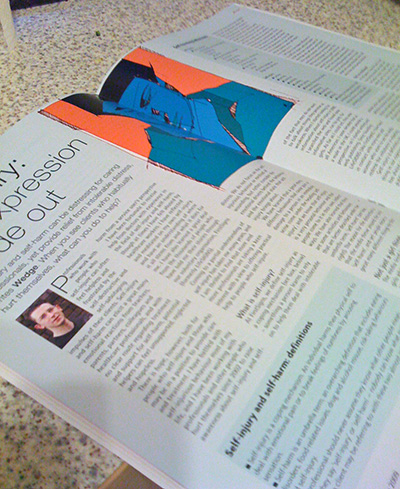Self-injury can be seen as a compulsion, but it is not something that just ‘happens to’ a person and is out of their control.
Self-injury is a choice; the person is choosing to cope as best they can. Although self-injury is a chronic syndrome, people can be directly helped to move away from it as a coping tool and make new and better choices. The results, which may not be dramatic, can be life changing.
The following distraction techniques may help.
The 15-minute rule
A professional can explain to a client that they have the choice to hurt themselves, and that their choice is not going to be taken away. The client needs to be encouraged to recognise their own power and then make a decision to put off the self-injury for just 15 minutes. After 15 minutes, they can choose to hurt themselves, or they can assess how their feelings are progressing and choose to wait another 15 minutes.
Surfing the urge
If a professional discusses with their client how it feels to have an emotion (like anger, love, or anxiety) build and grow to intolerable levels, it can be agreed that just as a wave of emotion builds, so it declines. Accepting that emotions (of all types) develop like waves can be a powerful meditation, especially when we focus on how we feel, say two per cent ‘better’ after reflection (perhaps during the 15-minute game).
State change
How we treat our body affects our thoughts and feelings; for example a person who is feeling afraid may make him or herself smaller by hunching their shoulders or hiding behind their hair. By changing their physical behaviour a person may thereby be able to break free from the cycle that leads to self-injury. Standing, breathing from the diaphragm and lifting the head and eyes will change one’s physical state. Washing up is another good activity when there is a need to break cyclical thoughts.
More alternatives and distraction techniques are available from www.lifesigns.org.uk/help/
However we tackle the behaviours around self-harm, we should always approach a person with compassion and respect. They are doing the best they can, and as professionals and carers we can help them to make real changes in their lives.
About the author
 Wedge (his real name) has been writing and speaking about self-injury for many years; as an adult he sometimes, just sometimes, cuts himself. You may contact Wedge on Wedge@lifesigns.org.uk www.lifesigns.org.uk
Wedge (his real name) has been writing and speaking about self-injury for many years; as an adult he sometimes, just sometimes, cuts himself. You may contact Wedge on Wedge@lifesigns.org.uk www.lifesigns.org.uk
This article (seven web pages) was first published in the Healthcare Counselling and Psychotherapy Journal (HCPJ) published by the British Association for Counselling & Psychotherapy (BACP), in January 2009, and is reproduced here with permission.
Previous page << ‘Care for yourself and your clients‘
View our organisation page on LinkedIn and follow LifeSIGNS for professional matters.
